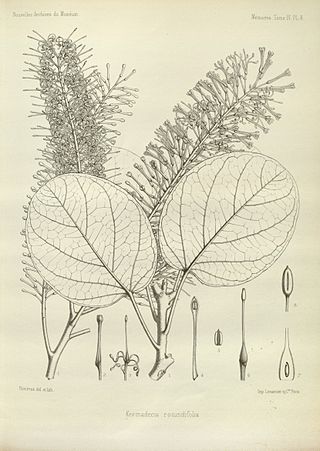
Macadamia is a genus of four species of trees in the flowering plant family Proteaceae. They are indigenous to Australia, native to northeastern New South Wales and central and southeastern Queensland specifically. Two species of the genus are commercially important for their fruit, the macadamia nut. Global production in 2015 was 160,000 tonnes. Other names include Queensland nut, bush nut, maroochi nut, bauple nut and, in the USA, they are also known as Hawaii nut. In Australian Aboriginal languages, the fruit is known by names such as bauple, gyndl or jindilli and boombera. It was an important source of bushfood for the Aboriginal peoples who are the original inhabitants of the area.

Hicksbeachia is a genus of two species of trees in the family Proteaceae. They are native to rainforests of northern New South Wales and southeastern Queensland. They are commonly known as red bopple nut or beef nut due to the bright red colour of their fruits.

The Proteaceae form a family of flowering plants predominantly distributed in the Southern Hemisphere. The family comprises 83 genera with about 1,660 known species. Australia and South Africa have the greatest concentrations of diversity. Together with the Platanaceae, Nelumbonaceae and in the recent APG IV system the Sabiaceae, they make up the order Proteales. Well-known 'Proteaceae genera include Protea, Banksia, Embothrium, Grevillea, Hakea and Macadamia. Species such as the New South Wales waratah, king protea, and various species of Banksia, Grevillea, and Leucadendron are popular cut flowers. The nuts of Macadamia integrifolia are widely grown commercially and consumed, as are those of Gevuina avellana on a smaller scale.

The Grevilleoideae are a subfamily of the plant family Proteaceae. Mainly restricted to the Southern Hemisphere, it contains around 46 genera and about 950 species. Genera include Banksia, Grevillea, and Macadamia.
Triunia is a genus of medium to tall shrubs or small trees found as understorey plants in rainforests of eastern Australia. Members of the plant family Proteaceae, they are notable for their poisonous fleshy fruits or drupes. Only one species, T. youngiana, is commonly seen in cultivation.

Beauprea is a genus of flowering plants in the family Proteaceae. Its 13 extant species are endemic to New Caledonia, though closely related forms have been found in the fossil records of Australia and New Zealand. Its closest extant relatives are the African Protea and Faurea.

Bleasdalea is a genus of flowering plants in the family Proteaceae.
Heliciopsis is a genus of about thirteen species of trees, constituting part of the flowering plant family Proteaceae. They grow naturally in Burma, Indo-China, SE. China, Thailand, Peninsular Malaysia, Borneo, Sumatra, Java (Indonesia) and the Philippines. The name means similar to the plant genus Helicia. Its closest relatives are Athertonia (Australia) and Virotia.
Kermadecia pronyensis is a species of plant in the family Proteaceae. It is endemic to New Caledonia. It is threatened by habitat loss.

Kermadecia is a genus of flowering plants in the family Proteaceae. The genus comprises eight species of rainforest trees from New Caledonia, Fiji, and Vanuatu. Its closest relative is Euplassa from South America.
Virotia neurophylla is a species of plant in the family Proteaceae. It is endemic to New Caledonia. It is threatened by habitat loss. It has recently been transferred to the genus Virotia, which is also endemic to New Caledonia.
Hermann Otto Sleumer was a Dutch botanist of German birth. The plant genera SleumerodendronVirot (Proteaceae) and SleumeriaUtteridge, Nagam. & Teo (Icacinaceae), are named for him.
Virotia is a genus of six species of flowering plants in the family Proteaceae. The genus is endemic to New Caledonia with six species that were once placed in Macadamia. Its closest relatives are the Australian Athertonia and the Asian Heliciopsis. The genus is named after Robert Virot, pioneer of ecological studies in New Caledonia and author of a monograph of New Caledonian Proteaceae.
Nothorites is a genus of a sole described species of trees, constituting part of the plant family Proteaceae. The species Nothorites megacarpus grows naturally only in restricted mountain regions (endemic) of the wet tropics rain forests of north-eastern Queensland, Australia.

Lasjia is a genus of five species of trees of the family Proteaceae. Three species grow naturally in northeastern Queensland, Australia and two species in Sulawesi, Indonesia. Descriptively they are the tropical or northern macadamia trees group. Lasjia species characteristically branched compound inflorescences differentiate them from the Macadamia species, of Australia, which have characteristically unbranched compound inflorescences and only grow naturally about 1,000 km (620 mi) further to the south, in southern and central eastern Queensland and in northeastern New South Wales.
Eucarpha is a genus of flowering plant of the family Proteaceae, endemic to New Caledonia. Two species are recognised. Up to 1975, these were classified within the genus Knightia until Lawrence Johnson and Barbara G. Briggs recognised their distinctness, particularly their prominent bracts, in their 1975 monograph "On the Proteaceae: the evolution and classification of a southern family". Nomenclatural combinations for these two species in the genus Eucarpha were published in 2022.

Garnieria is a monotypic plant genus in the family Proteaceae. Molecular hylogenetic studies indicate that it is nested in the larger Australian genus Persoonia where it may be included. It is endemic to New Caledonia where the type specimen was collected at Prony Bay in 1868–1870 by Benjamin Balansa. The only species is Garnieria spathulifolia.
Turrillia is a genus of plants in the family Proteaceae, native to Oceania.
Eucarpha deplanchei is a species of flowering plant in the family Proteaceae, native to New Caledonia. It was first described in 1865 as Knightia deplanchei.
Eucarpha strobilina, synonym Knightia strobilina, is a species of flowering plant in the family Proteaceae, native to New Caledonia.









